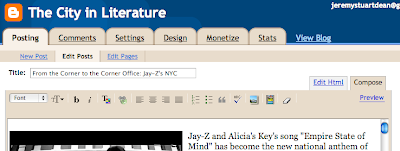Digital writing is a different kind of prose than a traditional English essay writing. As such, the grammar and formatting of a blog post differs from the formal expectations of a paper. Here are just a few ideas to consider as you design your blog posts.
- make full use of the WYSIWYG buttons
- text can be formatted in the same way as in a Word document, but the highly visual nature of online reading and writing makes such font tools even more effective
- at the very least, you should continue to italicize novels and use the appropriate formatting for other titles
- don't overdo it with such textual effects (as above) as that will distract from the content of your post
- certain rules that govern the conventional English essays written in Word do not apply in the blogosphere--for example, don't double space lines or indent paragraphs (in fact, you may need to remove certain formatting as you move text between Word and Blogger)
- make all links hyperlinks (I never want to see a URL, "http://blahblah.blah" in an entry)
- cite sources using hyperlinks to online content
- provide hyperlinks for your readers for more information on a topic
- acknowledge images sources (using hyperlinks)
- caption images
- instead of long paragraphs, think of using shorter groupings of text to break up the "page"
- add images and video to break up the text
- if you know HTML, feel free to use the added features through the programming language (you can, for example, make a certain song play while people read your entry!)
- tag, or as Blogger calls it, "label," your posts with keywords that allude to its content--this helps generate an organic index or table of contents for the class blog as a whole
For more tips on the format of digital writing, see the online version of the Web Style Guide, especially the Editorial Style chapter.
